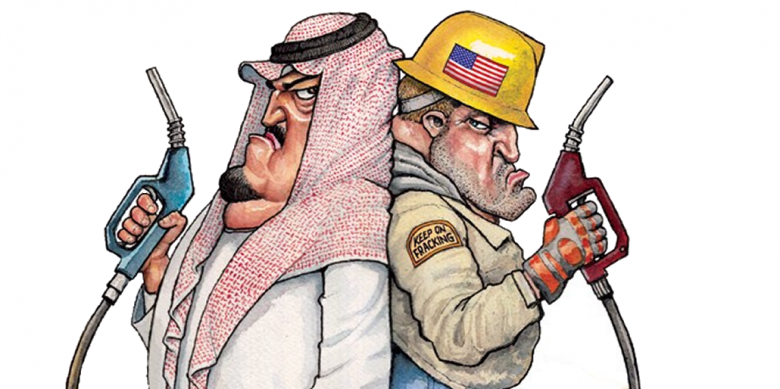
OPEC WILL BACK BY 2040

OGJ - The Organization of Petroleum Exporting Countries expects US unconventional crude oil production from tight shale formations to increase the country's global market influence through 2025, the chief economist for the cartel said on Dec. 7.
But Middle Eastern and Persian Gulf producers appear likely to regain their global market leadership by 2040, he added during a discussion about OPEC's 2017 World Oil Outlook at the Center for Strategic & International Studies in Washington, DC.
"Tight oil supplies are the wild card. They have reshaped the global outlook in recent years," observed Ayed S. Al-Qahtani, who directs the research division at the OPEC Secretariat in Vienna. "US tight oil supplies will be the most important contributor but are expected to reach their peak around 2025."
Producers in the Middle East, most of which are OPEC members, have supplies that are relatively less expensive to produce, but about $10.5 trillion of investments will be required in the next 23 years, he said.
"We expect their exports to increase significantly after 2025, mainly to Pacific Asia," said Al-Qahtani, adding that the forecast suggests demand will rise the most in China and India through 2040.
The outlook forecasts that global crude oil demand will climb to 102.3 million b/d by 2022 from 94.5 million b/d in 2016. Al-Qahtani said it appears likely to rise more quickly through 2020, when International Maritime Organization regulations for bunker fuels are due to take effect and more low-sulfur diesel fuel could be needed.
"In the longer term, we expect demand to reach 111.1 million b/d by 2040," he said. "Most of this will be in transportation, where competition from alternative fuels is weakest."
The number of passenger cars worldwide could double by 2040, largely driven by increases in economically developing countries, with electric vehicles representing 12% of the global fleet, Al-Qahtani said.
Downstream trends
"Downstream, refining capacity could increase by 19.6 million b/d by 2040, with Asia-Pacific and Middle East countries accounting for almost 70% of the total," he said. "We expect refiners to add capacity in the middle of demand centers because that's where the customers are." About $1.5 trillion of investments will be needed to accomplish this by 2040, he said.
Al-Qahtani said OPEC anticipates that total worldwide energy demand will climb 35%, or about 96 million boe/d, through 2040. Crude oil appears likely to remain dominant as natural gas gains the most ground. "Fossil fuels are expected to remain dominant," he said. "We expect technology, as well as policies, to continue driving emissions reductions and energy efficiency."
Developing countries also appear likely to drive long-term economic growth globally, Al-Qahtani said. "Demand in [Organization for Economic Cooperation and Development] countries should peak in the early 2030s as their governments try to move from oil and coal to renewables out of climate concerns," he said.
Responding to an audience member's question, Al-Qahtani said it is OPEC's policy not to try and predict specific prices. "We know that costs are going up, and we're running out of cheaper supplies. That suggests prices will be higher, even without additional taxes," he said.
"Predicting depletion rates is difficult. It's hard to predict when you'll run out of a resource," he said. "I think profitability is the most important factor in deciding how long to produce something."
Frank A. Verrastro, a senior vice-president and trustee fellow at CSIS who moderated the discussion, said, "A lot has changed in the last decade. The US clearly has a different role now than it did before, but it also faces a lot of above-ground challenges. How these are handled could determine how long this country's new market position will last."
-----
Earlier:

2017, December, 2, 18:54:00
OPEC CONFIRMEDOPEC - In agreeing to this decision, Member Countries confirmed their continued focus on a stable and balanced oil market, in the interests of both producers and consumers. Member Countries remain committed to being dependable and reliable suppliers of crude and products to global markets.
|

2017, November, 9, 14:00:00
OPEC: 2040 GLOBAL ENERGY CHANGESWithin the grouping of Developing countries, India and China are the two nations with the largest additional energy demand over the forecast period, both in the range of 22–23 mboe/d.
|

2017, October, 25, 12:30:00
OIL PRICES NO OPPORTUNITIES"They [big OPEC and Middle Eastern producers] cannot be too ambitious [on their oil price targets]...there's not much [upside] room for them to hope for," Sadamori said. "Once the oil price goes to certain levels, this will stimulate new drilling and investments in North America," he added.
|

2017, September, 15, 09:00:00
OIL PRICES: $50 - $60Oil prices are expected to hold between $50 and $60 a barrel as bloated global stocks fall after a deal between OPEC and other producers to trim output, BP Chief Executive Bob Dudley said on Thursday.
|

2017, August, 16, 09:30:00
OPEC: GLOBAL OIL DEMAND WILL UP TO 97.8 MBDOPEC said world oil demand in 2018 will grow 1.28 million b/d from 2017 levels, meaning that total oil consumption is expected to hit a new record high of 97.8 million b/d in 2018.
|

2017, May, 22, 16:35:00
OPEC: THE LOWEST REVENUESMembers of the Organization of the Petroleum Exporting Countries (OPEC) earned about $433 billion in net oil export revenues in 2016, the lowest since 2004. In real dollar terms, the 2016 revenue represents a 15% decline from the $509 billion earned in 2015, mainly because of the fall in average annual crude oil prices and, to a lesser extent, because of decreases in OPEC net oil exports.
|

2017, May, 10, 18:00:00
U.S. SHALE RISKThe resurgence of the US shale industry after the oil slump of 2014 was a key factor in how crude prices fell sharply last week, to back below $50 per barrel. The market is concerned about whether efforts by Opec, the producers’ cartel, to tackle a supply glut by curbing output will be undermined by reinvigorated US shale companies. |





